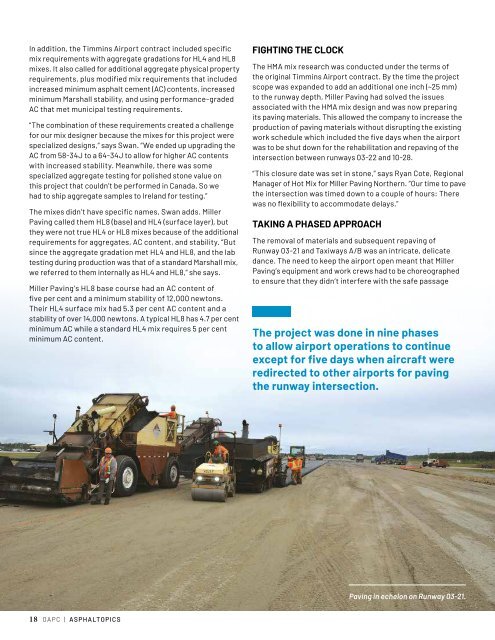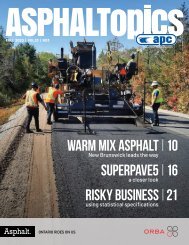ASPHALTopics | Summer 2021 | VOL 34 | NO 2
You also want an ePaper? Increase the reach of your titles
YUMPU automatically turns print PDFs into web optimized ePapers that Google loves.
In addition, the Timmins Airport contract included specific<br />
mix requirements with aggregate gradations for HL4 and HL8<br />
mixes. It also called for additional aggregate physical property<br />
requirements, plus modified mix requirements that included<br />
increased minimum asphalt cement (AC) contents, increased<br />
minimum Marshall stability, and using performance-graded<br />
AC that met municipal testing requirements.<br />
“The combination of these requirements created a challenge<br />
for our mix designer because the mixes for this project were<br />
specialized designs,” says Swan. “We ended up upgrading the<br />
AC from 58-<strong>34</strong>J to a 64-<strong>34</strong>J to allow for higher AC contents<br />
with increased stability. Meanwhile, there was some<br />
specialized aggregate testing for polished stone value on<br />
this project that couldn’t be performed in Canada. So we<br />
had to ship aggregate samples to Ireland for testing.”<br />
The mixes didn’t have specific names, Swan adds. Miller<br />
Paving called them HL8 (base) and HL4 (surface layer), but<br />
they were not true HL4 or HL8 mixes because of the additional<br />
requirements for aggregates, AC content, and stability. “But<br />
since the aggregate gradation met HL4 and HL8, and the lab<br />
testing during production was that of a standard Marshall mix,<br />
we referred to them internally as HL4 and HL8,” she says.<br />
Miller Paving’s HL8 base course had an AC content of<br />
five per cent and a minimum stability of 12,000 newtons.<br />
Their HL4 surface mix had 5.3 per cent AC content and a<br />
stability of over 14,000 newtons. A typical HL8 has 4.7 per cent<br />
minimum AC while a standard HL4 mix requires 5 per cent<br />
minimum AC content.<br />
FIGHTING THE CLOCK<br />
The HMA mix research was conducted under the terms of<br />
the original Timmins Airport contract. By the time the project<br />
scope was expanded to add an additional one inch (~25 mm)<br />
to the runway depth, Miller Paving had solved the issues<br />
associated with the HMA mix design and was now preparing<br />
its paving materials. This allowed the company to increase the<br />
production of paving materials without disrupting the existing<br />
work schedule which included the five days when the airport<br />
was to be shut down for the rehabilitation and repaving of the<br />
intersection between runways 03-22 and 10-28.<br />
“This closure date was set in stone,” says Ryan Cote, Regional<br />
Manager of Hot Mix for Miller Paving Northern. “Our time to pave<br />
the intersection was timed down to a couple of hours: There<br />
was no flexibility to accommodate delays.”<br />
TAKING A PHASED APPROACH<br />
The removal of materials and subsequent repaving of<br />
Runway 03-21 and Taxiways A/B was an intricate, delicate<br />
dance. The need to keep the airport open meant that Miller<br />
Paving’s equipment and work crews had to be choreographed<br />
to ensure that they didn’t interfere with the safe passage<br />
The project was done in nine phases<br />
to allow airport operations to continue<br />
except for five days when aircraft were<br />
redirected to other airports for paving<br />
the runway intersection.<br />
Paving in echelon on Runway 03-21.<br />
18 OAPC | ASPHALTOPICS

















